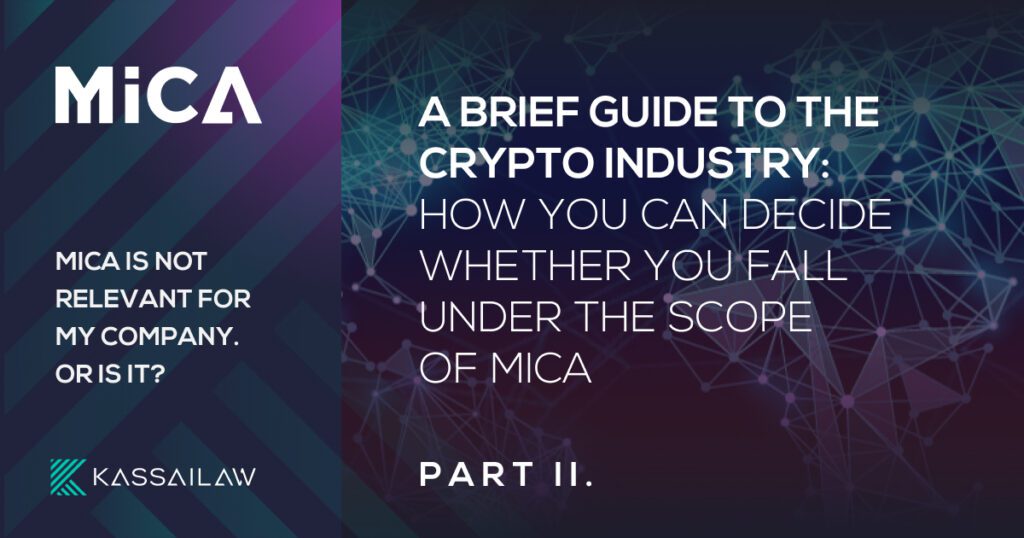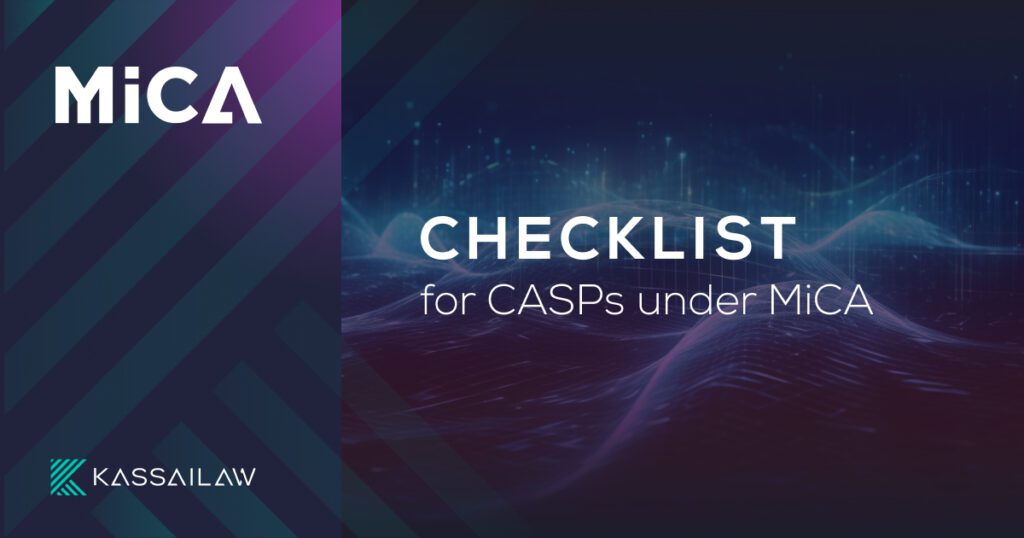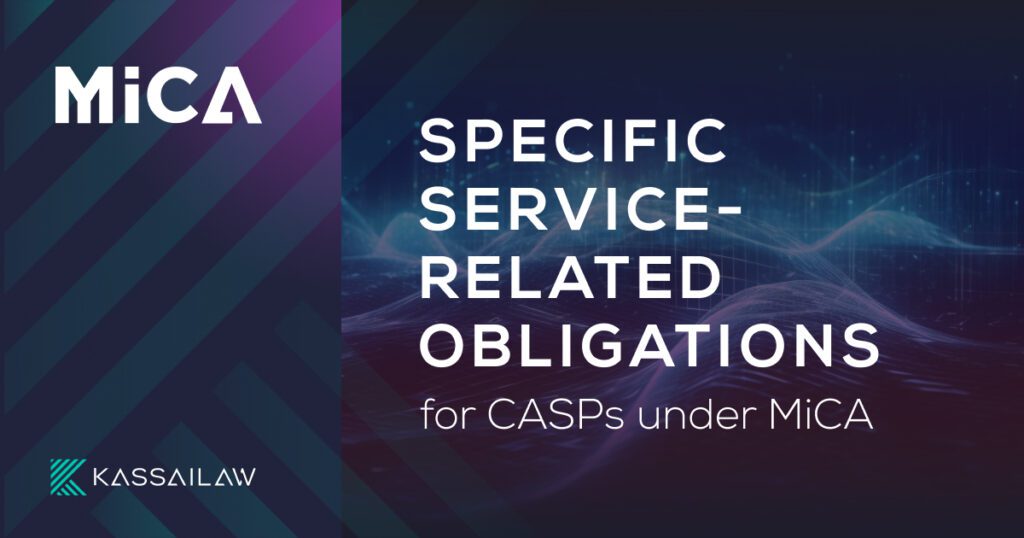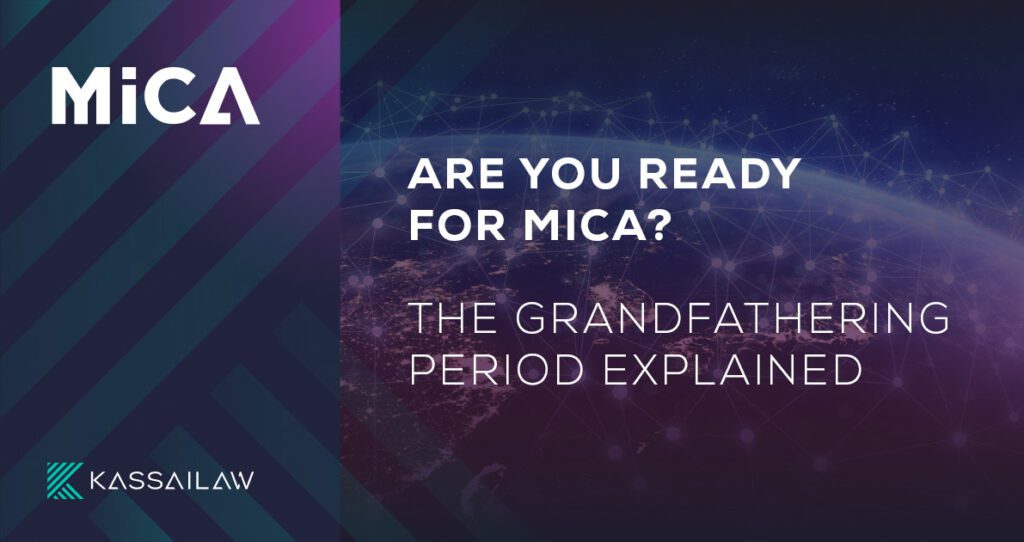Decoding

Get prepared
with KassaiLaw


Game of Crypto Thrones
Global Debate on Regulatory Approaches to Crypto-assets

WHAT IS MiCA?
MiCA (the European Union’s Market in Crypto-asset Regulation), came into force in June 2023, stands as a groundbreaking regulation aiming to provide a comprehensive framework for the crypto industry in the EU. It addresses the challenges and opportunities posed by crypto-assets, setting standards to enhance market integrity, investor protection, and overall regulatory clarity.
For in-depth details on the European Union’s Market in Crypto-asset Regulation,
visit the official regulation document here.

WHAT KIND OF CRYPTO-ASSETS ARE COVERED BY MiCA?
The classification of various crypto assets is rooted in one primary factor.
– whether the cryptos in question tied their value to, or in other words, whether they are seeking to stabilize their value by another asset.
MiCA employs this criteria to categorize crypto-assets into three main groups.
1. E-MONEY TOKENS (EMTS)
E-money tokens’ aim is to stabilize their value by referencing only one official currency. The name came to be because of Directive 2009/110/EC definition of electronic money. The function of that Directive’s electric money is to be electronic surrogates for physical money and there is a high chance they will be used for payments. The similarity in purpose between the two, gave reason to label them similar as well.
Example: Tether or USDC.
In practice: If you are planning on issuing tokens which stabilize their value by an official currency, like euro, be aware that they might qualify for e-money tokens, which not only makes you fall under the scope of MiCA but also need you to be qualified as either a credit institution or an electric money institution since these tokens can only be issued by these corporations. Keep also in mind, that these organization forms must comply with serious rules in order to operate so such projects require serious regulatory compliance efforts from your end.
2. ASSET-REFERENCED TOKENS (ARTS)
Asset-referenced tokens are crypto-assets, which reference another right or value, like fiat currency or a physical asset, or a combination of the priors, but is not an e-money token. It is important that asset-referenced tokens are defined by using the definition of e-money tokens: only a token which is referencing another value but still cannot be qualified as an e-money token can be classified as such. When it comes to the stabilization of their values, even one or several official currencies can be used as such.
Example: Pax gold or diam. Furthermore, stablecoins are seemed to be categorized as asset-referenced tokens.
In practice: Important to note, that asset-referenced tokens carry a higher risk in terms of protection for its holders because they can be easily adopted to transfer or as means of exchange, therefore, offerors of these tokens are subject to heavier requirements of licensing and operations, like the obligation to be established in the Union.
3. OTHER TOKENS
Every other token, which are referencing another asset for their value, but are not asset-referenced tokens or e-money tokens belong to the third, ‘other’ category.
Example: Utility tokens, Ethereum gas tokens or Binance tokens.
NOT INCLUDED IN MICA:
- crypto-assets that qualify as financial instruments in Directive 2014/65/EU,
- crypto-assets that those that qualify as deposits in Directive 2014/49/EU,
- crypto-assets that including structured deposits in Directive 2014/65/EU.
HOW TO CLASSIFY NON-FUNGIBLE CRYPTO-ASSETS (NFTS)?
Exempt from MiCA:
- digital art,
- collectibles,
- those that represent services or physical assets (e.g. real estate or product guarantees)
Included in the scope of MiCA:
- fractional parts of a unique and non-fungible crypto-asset
- issuance of crypto-assets as non-fungible tokens in a large series or collection
- crypto-assets that appear to be unique, but upon examination its real features or features that are linked to usage turn out to be not unique.
More in detail: Scope 1

WHAT ACTIVITIES ARE DEEMED AS CRYPTO-ASSET SERVICES?
CASPs, aka crypto-asset service providers are legal persons or other undertakings –– whose goal is the provision of one or more crypto-asset services. It is important to note that natural persons are missing from the definition which means that you need to establish an entity to be able to provide crypto-asset services. These services should be provided to clients on a professional basis, as fully decentralized services – so services without any intermediary – do not fall within the scope of MiCA.
Additional requirement for a CASP is to comply with Article 59 of MiCA on Authorisation. The services which qualify as crypto-asset services under MiCA are the following:
In this case, the service happens on behalf of clients. The provision of custody and administration entails the safekeeping or controlling of crypto-assets or accessing such crypto-assets with a private cryptographic key, where the latter is relevant. This could be identified with custody and admin services.
By operation the regulation means the management of one or several multilateral systems, which based on the system itself and its rules makes it possible for multiple third-party to purchase and sell interests in crypto-assets. This transaction can either be an exchange of crypto-assets for funds or exchange of crypto-assets for other crypto-assets.
With this exchange, the service provider concludes purchase or sale contracts regarding crypto-assets with clients by using proprietary capital. As the name indicates, it can only happen in exchange for funds.
This is the same as the above case, but the object of the exchange is different: the exchange happens for other crypto-assets.
In this case, the service provider acts on behalf of clients, and conclude agreements, purchase or sell a crypto-asset or more crypto-assets or subscribe for one or more crypto-assets. This also entails conclusion of contracts to sell crypto-assets at the moment of their offer to the public or admission to trading.
By placing the regulation means marketing activities on behalf of or for the account of the offeror, or it can happen on behalf of or for a party related to the offeror. The marketing is of crypto-assets and it is communicated to third-party purchasers.
This service means that the crypto-asset service provider receives orders from a person to purchase or sell one or more crypto-assets or to subscribe for one or more crypto-assets. The service provider is also entrusted with the transmission of that order to a third party for execution.
This might be the most surprising service in the CASPs’ list. By the provision of advice the regulation means ‘offering, giving or agreeing to give personalised recommendations to a client, either at the client’s request or on the initiative of the crypto-asset service provider providing the advice, in respect of one or more transactions relating to crypto-assets, or the use of crypto-asset services’. This means that giving advice regarding crypto-assets counts also as crypto-asset service.
In this case, the service is described as the management of portfolios at the clients’ direction. It is on a discretionary client-by-client basis where these portfolios include one or more crypto-assets.
This is a rather simple service which entails the transfer of crypto-assets from one distributed ledger (DTL) address or account to another. The client can be natural or legal person.
Important to note: advisory services
Advisory services will count as crypto-asset services, so even if a legal person or an undertaking want to participate in nothing but consultancy, the necessary authorization must be made for compliance with MiCA. The regulation specifies that the advice – to be considered advice on crypto-assets – needs to be regarding transactions or on the usage of crypto-services. The regulation also sets out certain requirements for the provided advice. Among others:
They shall establish whether the crypto-asset is suitable for the client, while bearing in mind the client’s:
- knowledge and experience in investing in crypto-assets,
- investment objectives like risk tolerance, and
- financial situation.
They should also inform the clients, whether the advice is based on
- independent basis or
- broad or restricted analysis

WHAT ARE YOUR TASKS AND WHAT ARE THE DEADLINES IF YOU FALL UNDER MiCA?
MiCA entered into force on June 29, 2023, with different titles becoming applicable in stages.
In June 2024
• Title III (Asset-Referenced Tokens) and
• Title IV (E-Money Tokens)
In December 2024
• Title I (Subject matter, scope and definitions),
• Title II (Crypto-assets other than asset-referenced tokens or e-money tokens),
• Title V (Authorisation and operating conditions for crypto-asset service providers),
• Title VI (Prevention and prohibition of market abuse involving crypto-assets), and
• Title VII (Competent authorities, EBA and ESMA)
Entities falling under MiCA should prepare for the transition and understand the significance of this regulation on a global scale.
At KassaiLaw, we believe that MiCA is a significant milestone in the regulation of the crypto industry. Our team is committed to helping clients understand and comply with MiCA, ensuring a smooth transition into this new regulatory era. Stay tuned for more updates on MiCA and its impact on the evolving crypto landscape.

















